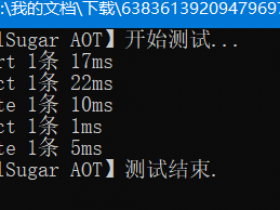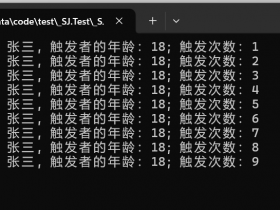- A+
序列化、反序列化对象常用的两种方式
序列化和反序列化对象常用的两种方式
序列化是使用指定的格式将一个或多个对象转换为字节序列的过程。反序列化则是相反的过程。
我们这里记录2个常用的序列化和反序列化方法。
1、序列化为XML
2、系列化为JSON
一、序列化和反序列化XML
1.1、序列化XML
创建一个WPF程序。
新建一个类文件命名为Person,同时我们引用以下名称空间,创建Person的类中的属性,
使用[XmlAtribute("fname")]属性,会把按当前类属性从子节点变为当前节点的属性,文件大小就变小了。可以尝试一下去掉和不去掉之后产生的XML是否一样。
using System; //DateTime using System.Collections.Generic; //List<T>,HashSet<T> using System.Xml.Serialization; //XmlSerializer namespace SerializationAndDeserialization { public class Person { public Person() { } public Person(decimal initialSalary) { Salary = initialSalary; } [XmlAttribute("fname")] public string FirstName { get; set; } [XmlAttribute("lname")] public string LastName { get; set; } [XmlAttribute("dob")] public DateTime DateOfBirth { get; set; } public HashSet<Person> Children { get; set; } protected decimal Salary { get; set; } } } 在MainWindow.cs文件中我们在构造函数中实例化Person。序列化到文件中,然后再反序列化回来。同时我们观察使用XmlAttribute和不使用XmlAttribute有什么差别、观察属性定义为public类型和protected类型再序列化和反序列化过程中有什么不同。
using System; using System.Collections.Generic; using System.Xml.Serialization; using System.IO; using System.Windows; using static System.Console; using static System.Environment; using static System.IO.Path; namespace SerializationAndDeserialization { /// <summary> /// MainWindow.xaml 的交互逻辑 /// </summary> public partial class MainWindow : Window { public MainWindow() { InitializeComponent(); var people = new List<Person>() { new Person(30000M){ FirstName="Alice",LastName="Smith",DateOfBirth=new DateTime(1974,3,14)}, new Person(40000M){ FirstName="Bob",LastName="Jone",DateOfBirth=new DateTime(1969,11,23)}, new Person(20000M){ FirstName="Charlie",LastName="Cox",DateOfBirth=new DateTime(1984,5,4),Children=new HashSet<Person>{ new Person(0M) { FirstName="Sally",LastName="Cox",DateOfBirth=new DateTime(2000,7,12)} } } }; var xs = new XmlSerializer(typeof(List<Person>)); string path = Combine(CurrentDirectory, "pepple.xaml"); using (FileStream stream = File.Create(path)) { xs.Serialize(stream, people); } WriteLine("Witeten {0:N0} bytes of XML to {1}", arg0: new FileInfo(path).Length, arg1: path); WriteLine(); WriteLine(File.ReadAllText(path)); //系列化文件中不包含Salary,因为是Protected类型。 //引用System.Xml.Serialization后使用[XmlAtribute("fname")]添加特性。文件结构就改变了,同时文件变小了。 } } } 
左边是不使用再类属性上添加 [XmlAttribute("")]的方法生成的xml文件。右侧是使用 [XmlAttribute("")]属性。右侧文件小了很多。
1.2、反序列化XML
我们现在反序列化这个XML文件。
我们添加代码后完整代码如下:
using System; using System.Collections.Generic; using System.Xml.Serialization; using System.IO; using System.Windows; using static System.Console; using static System.Environment; using static System.IO.Path; namespace SerializationAndDeserialization { /// <summary> /// MainWindow.xaml 的交互逻辑 /// </summary> public partial class MainWindow : Window { public MainWindow() { InitializeComponent(); var people = new List<Person>() { new Person(30000M){ FirstName="Alice",LastName="Smith",DateOfBirth=new DateTime(1974,3,14)}, new Person(40000M){ FirstName="Bob",LastName="Jone",DateOfBirth=new DateTime(1969,11,23)}, new Person(20000M){ FirstName="Charlie",LastName="Cox",DateOfBirth=new DateTime(1984,5,4),Children=new HashSet<Person>{ new Person(0M) { FirstName="Sally",LastName="Cox",DateOfBirth=new DateTime(2000,7,12)} } } }; var xs = new XmlSerializer(typeof(List<Person>)); string path = Combine(CurrentDirectory, "pepple.xaml"); using (FileStream stream = File.Create(path)) { xs.Serialize(stream, people); } WriteLine("Witeten {0:N0} bytes of XML to {1}", arg0: new FileInfo(path).Length, arg1: path); WriteLine(); WriteLine(File.ReadAllText(path)); //系列化文件中不包含Salary,因为是Protected类型。 //引用System.Xml.Serialization后使用[XmlAtribute("fname")]添加特性。文件结构就改变了,同时文件变小了。 //反序列化 using (FileStream xmlLoad = File.Open(path, FileMode.Open)) { var loadedPeople = (List<Person>)xs.Deserialize(xmlLoad); foreach (var item in loadedPeople) { WriteLine($"{item.LastName} has {item.Children.Count} children."); } } } } } 点击运行,我们观察VS的输出中这三行Log。我们的反序列化就完成了。
Smith has 0 children. Jone has 0 children. Cox has 1 children. 二、序列化和反序列化JSON
使用JSON序列化格式的最流行的.NET库之一是Newtonsoft.Json,又名Json.NET。
我们再项目右键点击弹出菜单中选择管理NuGet包,点击浏览输入Newtonsoft.Json。选中找到的Newtonsoft.Json,点击安装。
2.1、尝试序列化信息为JSON,并存放到文本文件中。
我们再后面添加如下代码
using System; using System.Collections.Generic; using System.Xml.Serialization; using System.IO; using System.Windows; using static System.Console; using static System.Environment; using static System.IO.Path; namespace SerializationAndDeserialization { /// <summary> /// MainWindow.xaml 的交互逻辑 /// </summary> public partial class MainWindow : Window { public MainWindow() { InitializeComponent(); var people = new List<Person>() { new Person(30000M){ FirstName="Alice",LastName="Smith",DateOfBirth=new DateTime(1974,3,14)}, new Person(40000M){ FirstName="Bob",LastName="Jone",DateOfBirth=new DateTime(1969,11,23)}, new Person(20000M){ FirstName="Charlie",LastName="Cox",DateOfBirth=new DateTime(1984,5,4),Children=new HashSet<Person>{ new Person(0M) { FirstName="Sally",LastName="Cox",DateOfBirth=new DateTime(2000,7,12)} } } }; var xs = new XmlSerializer(typeof(List<Person>)); string path = Combine(CurrentDirectory, "pepple.xaml"); using (FileStream stream = File.Create(path)) { xs.Serialize(stream, people); } WriteLine("Witeten {0:N0} bytes of XML to {1}", arg0: new FileInfo(path).Length, arg1: path); WriteLine(); WriteLine(File.ReadAllText(path)); //系列化文件中不包含Salary,因为是Protected类型。 //引用System.Xml.Serialization后使用[XmlAtribute("fname")]添加特性。文件结构就改变了,同时文件变小了。 //反序列化 using (FileStream xmlLoad = File.Open(path, FileMode.Open)) { var loadedPeople = (List<Person>)xs.Deserialize(xmlLoad); foreach (var item in loadedPeople) { WriteLine($"{item.LastName} has {item.Children.Count} children."); } } //序列化JSON string jsonPath = Combine(CurrentDirectory, "prople.json"); using (StreamWriter jsonStream = File.CreateText(jsonPath)) { var jss = new Newtonsoft.Json.JsonSerializer(); jss.Serialize(jsonStream, people); } WriteLine(); WriteLine($"Written {new FileInfo(jsonPath).Length} bytes of JSON to :{jsonPath}"); WriteLine(File.ReadAllText(jsonPath)); } } } 调试运行输出找到Log关键行如下。
Written 365 bytes of JSON to :E:C#NotesWPF技巧SerializationAndDeserializationSerializationAndDeserializationbinDebugprople.json [{"FirstName":"Alice","LastName":"Smith","DateOfBirth":"1974-03-14T00:00:00","Children":null},{"FirstName":"Bob","LastName":"Jone","DateOfBirth":"1969-11-23T00:00:00","Children":null},{"FirstName":"Charlie","LastName":"Cox","DateOfBirth":"1984-05-04T00:00:00","Children":[{"FirstName":"Sally","LastName":"Cox","DateOfBirth":"2000-07-12T00:00:00","Children":null}]}] 2.2反序列化JSON文件为对象
反序列化的过程,我们使用File读取文件内容,然后使用JsonConvert.DeserializeObject 来反序列化到对象。具体代码如下:
using System; using System.Collections.Generic; using System.Xml.Serialization; using System.IO; using System.Windows; using static System.Console; using static System.Environment; using static System.IO.Path; using Newtonsoft.Json; using System.Runtime.Serialization.Formatters.Binary; using System.Diagnostics; namespace SerializationAndDeserialization { /// <summary> /// MainWindow.xaml 的交互逻辑 /// </summary> public partial class MainWindow : Window { public MainWindow() { InitializeComponent(); var people = new List<Person>() { new Person(30000M){ FirstName="Alice",LastName="Smith",DateOfBirth=new DateTime(1974,3,14)}, new Person(40000M){ FirstName="Bob",LastName="Jone",DateOfBirth=new DateTime(1969,11,23)}, new Person(20000M){ FirstName="Charlie",LastName="Cox",DateOfBirth=new DateTime(1984,5,4),Children=new HashSet<Person>{ new Person(0M) { FirstName="Sally",LastName="Cox",DateOfBirth=new DateTime(2000,7,12)} } } }; //序列化XML var xs = new XmlSerializer(typeof(List<Person>)); string path = Combine(CurrentDirectory, "pepple.xaml"); using (FileStream stream = File.Create(path)) { xs.Serialize(stream, people); } WriteLine("Witeten {0:N0} bytes of XML to {1}", arg0: new FileInfo(path).Length, arg1: path); WriteLine(); WriteLine(File.ReadAllText(path)); //系列化文件中不包含Salary,因为是Protected类型。 //引用System.Xml.Serialization后使用[XmlAtribute("fname")]添加特性。文件结构就改变了,同时文件变小了。 //反序列化XML using (FileStream xmlLoad = File.Open(path, FileMode.Open)) { var loadedPeople = (List<Person>)xs.Deserialize(xmlLoad); foreach (var item in loadedPeople) { WriteLine($"{item.LastName} has {item.Children.Count} children."); } } //序列化JSON string jsonPath = Combine(CurrentDirectory, "prople.json"); using (StreamWriter jsonStream = File.CreateText(jsonPath)) { var jss = new Newtonsoft.Json.JsonSerializer(); jss.Serialize(jsonStream, people); } WriteLine(); WriteLine($"Written {new FileInfo(jsonPath).Length} bytes of JSON to :{jsonPath}"); //反序列化JSON var jsonStr = File.ReadAllText(jsonPath); WriteLine(File.ReadAllText(jsonPath)); var persons = JsonConvert.DeserializeObject<List<Person>>(jsonStr); foreach (var item in persons) { Debug.WriteLine(item.ToString()); } } } } 再Person中重写ToString()方法用于再反序列化结束后打印输出内容。
using System; //DateTime using System.Collections.Generic; //List<T>,HashSet<T> using System.Xml.Serialization; //XmlSerializer namespace SerializationAndDeserialization { public class Person { public Person() { } public Person(decimal initialSalary) { Salary = initialSalary; } [XmlAttribute("fname")] public string FirstName { get; set; } [XmlAttribute("lname")] public string LastName { get; set; } [XmlAttribute("dob")] public DateTime DateOfBirth { get; set; } public HashSet<Person> Children { get; set; } protected decimal Salary { get; set; } public override string ToString() { return $"FirstName:{FirstName},LastName:{LastName},DateOfBirth:{DateOfBirth}"; } } } 整体代码如上,序列化xml和反序列化xml,序列化json和反序列化json都再上面。适用于NET Core之前的版本。Net Core之后的有System.Text.Json对象。




